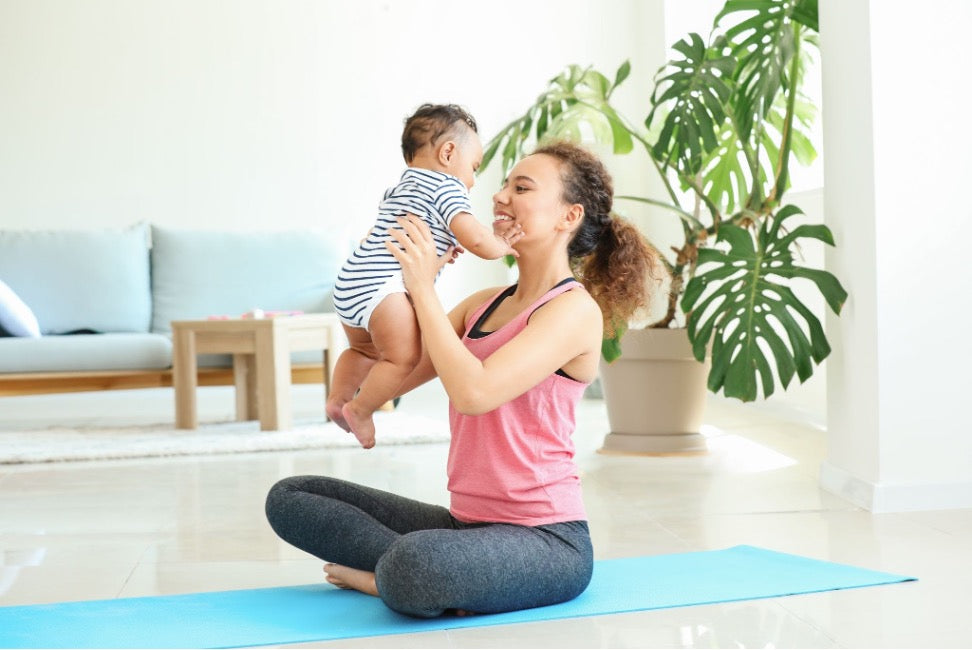If you've recently gave birth, you might be itching to exercise again, but before you take that first step, there’s a few recovery steps you’ll want to consider!
In this complete postpartum guide, we will share everything you need to know about what’s happening within the body and offer a few simple ways you can intentionally care for its transition back to a regular exercise routine.
The general rule of thumb to return to normal physical activity is 6 weeks postpartum, after gaining clearance from your care provider. However, there is so much more you need to know than a general thumbs up.
Postpartum Physical Healing:

Some providers may check you for diastasis recti (abdominal separation) and pelvic floor or organ prolapse, but not all do so without specifically asking for this information. If you would like to know how to check yourself for diastasis recti please read this quick guide. If you gave birth via cesarean or had perineal tearing/episiotomy, you have stitches that need to heal properly. These wounds require time and aftercare to allow the skin to have mobility at the scar site. For some, this takes longer to regain full range of motion and sensation. Speaking with your provider and possibly a physical therapist can be helpful to learn optimal care. I always suggest this brilliant infosheet from pelvic floor occupational therapist Lindsey Vestal of The Functional Pelvis for scar healing. Everyone who gave birth, whether vaginally or abdominally, will experience bleeding, lochia. How long bleeding lasts after pregnancy varies from person to person. It is recommended to wait to return to exercise until it has stopped.
Another super important part of your anatomy that requires healing is often overlooked - the uterus! This incredible organ grew 200x in size during pregnancy, grew a fetus and placenta, and then magically birthed them both from your body. The dinner plate-sized space where the placenta was attached to the uterine wall needs recover. The uterus itself takes around 6 weeks after birth to contract down to a prepregnancy size of about a fist. You may notice that increasing exercise increases vaginal bleeding. That’s your body’s way of telling you to slow it down. Your body has taken 10 months to grow and birth an entire human being and placenta from scratch, and requires a minimum of 6 weeks to recover. Give your incredible body a gentle rest to honor the absolute magic that it inhabits.
Let’s Get Moving:

Lifting your baby, moving through your life and just daily function is actually exercise. If you look at exercise from a functional point of view, you’ll realize how soon after birth you can begin reconnecting to your body- immediately! Learning or relearning how to do core belly breathing with pelvic floor engagement will support you in your recovery and can be started as soon as you give birth. Immediately after birth, the abdominal muscles are further apart and you may feel a hollow sensation in your belly space. Core belly engagement will help support your muscles return to a nonpregnant state. Activating pelvic floor muscles will support the abdominal muscles, uterus, bladder, bowels and reduce incontinence that is common after birth. You can take this “exercise” with you wherever you are. Picking your baby up from their bassinet, taking your dog for a walk, getting up from a chair, walking stairs, you get the idea.
Once you’ve mastered core belly breathing with pelvic floor engagement, you’ve gotten the A-OK from your care provider and you feel ready, you can safely begin an exercise regime. Set expectations, start slow and mindfully. You will not be returning back to where you left off at the gym. Do not have immediate expectations of your belly returning to it’s previous form. Pay attention to how your body responds and LISTEN. Ideally, start your fitness program with a skilled postpartum fitness trainer or a dedicated postpartum fitness program. There are many out there today at a variety of price points, making it far more accessible and affordable than ever before. I personally love Joanie Johnson of Strong Mom Society. A trained postpartum fitness expert will guide you through an assessment of where your body is at this point in time, any imbalances, and exercises to help correct them. You may start slower than you had envisioned but will be supporting your new body and all of the adjustments it has and is currently making.
Final Verdict?

So, when can you get back to the gym? Well, the answer isn’t as cut and dry as it seems. Because each individual requires a unique level of care, we encourage you to tune in, go slow, and give yourself grace as you adjust to this new phase of life.
Online Resources
Jamie Jones (trainer)
Maddy Wasserman (trainer)
The Functional Pelvis (pelvic floor OT)
By: Erin Pasquet
Birth and Postpartum Doula
Childbirth Educator
Certified Lactation Counselor
Pre/Post Natal Yoga Teacher



